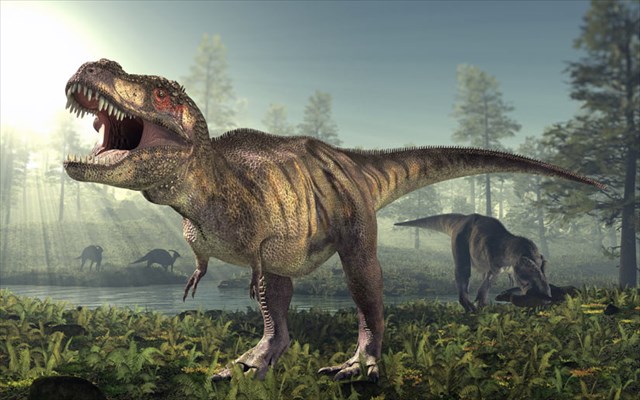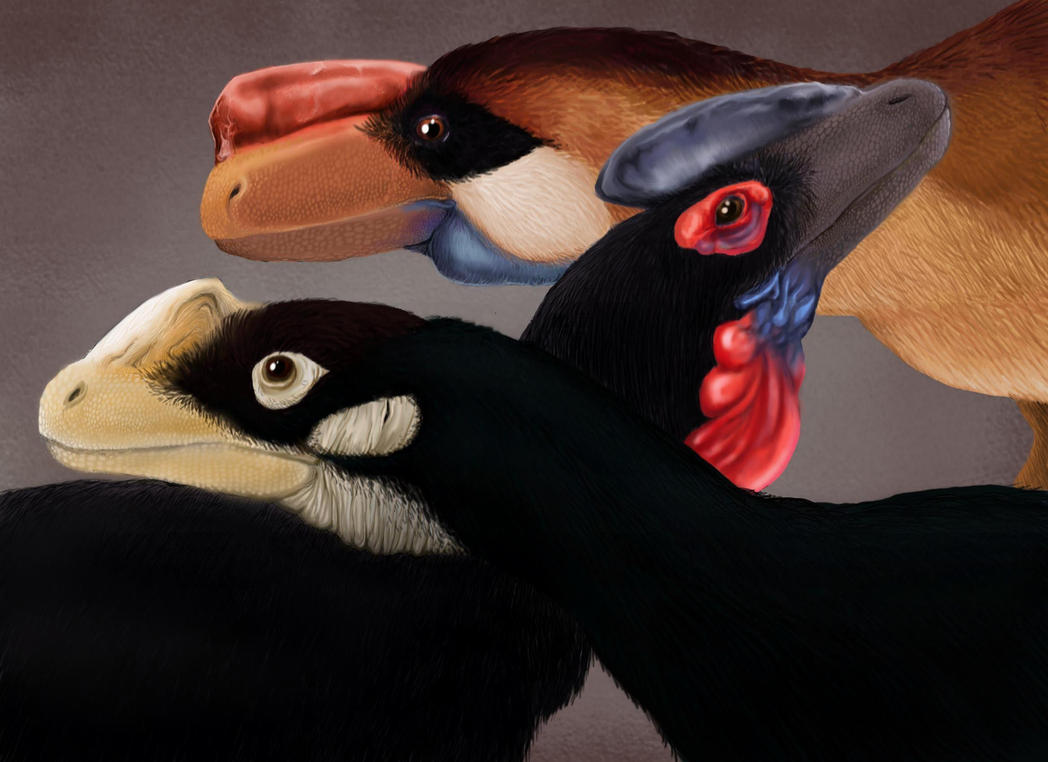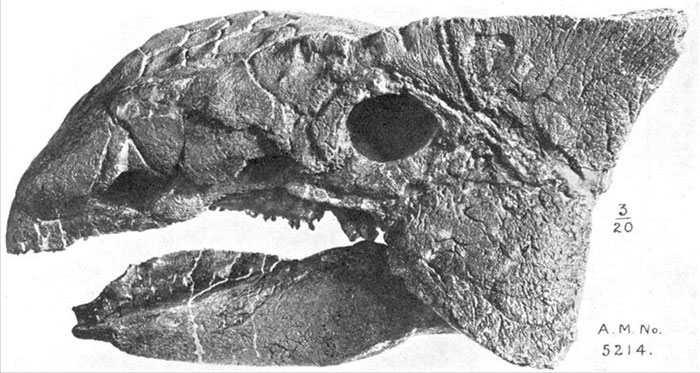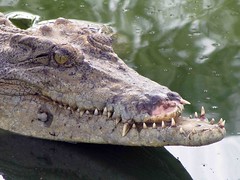Post by DinosaurMichael on Sept 25, 2013 1:02:47 GMT 5
Tyrannosaurus rex
Tyrannosaurus (/t??ræn??s?r?s/ or /ta??ræn??s?r?s/; meaning "tyrant lizard", from Greek tyrannos (
 ??) meaning "tyrant," and sauros (
??) meaning "tyrant," and sauros (
 ) meaning "lizard") is a genus of coelurosaurian theropod dinosaur. The species Tyrannosaurus rex (rex meaning "king" in Latin), commonly abbreviated to T. rex, is a fixture in popular culture. It lived throughout what is now western North America, at the time an island continent termed Laramidia, with a much wider range than other tyrannosaurids. Fossils are found in a variety of rock formations dating to the Maastrichtian age of the upper Cretaceous Period, 67 to 65.5 million years ago. It was among the last non-avian dinosaurs to exist before the Cretaceous–Paleogene extinction event. Like other tyrannosaurids, Tyrannosaurus was a bipedal carnivore with a massive skull balanced by a long, heavy tail. Relative to the large and powerful hindlimbs, Tyrannosaurus forelimbs were small, though unusually powerful for their size, and bore two clawed digits. Although other theropods rivaled or exceeded Tyrannosaurus rex in size, it was the largest known tyrannosaurid and one of the largest known land predators, measuring up to 12.8 m (42 ft) in length, up to 4 metres (13 ft) tall at the hips, and up to 6.8 metric tons (7.5 short tons) in weight. By far the largest carnivore in its environment, Tyrannosaurus rex may have been an apex predator, preying upon hadrosaurs and ceratopsians, although some experts have suggested it was primarily a scavenger. The debate over Tyrannosaurus as apex predator or scavenger is among the longest running in paleontology. More than 30 specimens of Tyrannosaurus rex have been identified, some of which are nearly complete skeletons. Soft tissue and proteins have been reported in at least one of these specimens. The abundance of fossil material has allowed significant research into many aspects of its biology, including life history and biomechanics. The feeding habits, physiology and potential speed of Tyrannosaurus rex are a few subjects of debate. Its taxonomy is also controversial, with some scientists considering Tarbosaurus bataar from Asia to represent a second species of Tyrannosaurus and others maintaining Tarbosaurus as a separate genus. Several other genera of North American tyrannosaurids have also been synonymized with Tyrannosaurus.
) meaning "lizard") is a genus of coelurosaurian theropod dinosaur. The species Tyrannosaurus rex (rex meaning "king" in Latin), commonly abbreviated to T. rex, is a fixture in popular culture. It lived throughout what is now western North America, at the time an island continent termed Laramidia, with a much wider range than other tyrannosaurids. Fossils are found in a variety of rock formations dating to the Maastrichtian age of the upper Cretaceous Period, 67 to 65.5 million years ago. It was among the last non-avian dinosaurs to exist before the Cretaceous–Paleogene extinction event. Like other tyrannosaurids, Tyrannosaurus was a bipedal carnivore with a massive skull balanced by a long, heavy tail. Relative to the large and powerful hindlimbs, Tyrannosaurus forelimbs were small, though unusually powerful for their size, and bore two clawed digits. Although other theropods rivaled or exceeded Tyrannosaurus rex in size, it was the largest known tyrannosaurid and one of the largest known land predators, measuring up to 12.8 m (42 ft) in length, up to 4 metres (13 ft) tall at the hips, and up to 6.8 metric tons (7.5 short tons) in weight. By far the largest carnivore in its environment, Tyrannosaurus rex may have been an apex predator, preying upon hadrosaurs and ceratopsians, although some experts have suggested it was primarily a scavenger. The debate over Tyrannosaurus as apex predator or scavenger is among the longest running in paleontology. More than 30 specimens of Tyrannosaurus rex have been identified, some of which are nearly complete skeletons. Soft tissue and proteins have been reported in at least one of these specimens. The abundance of fossil material has allowed significant research into many aspects of its biology, including life history and biomechanics. The feeding habits, physiology and potential speed of Tyrannosaurus rex are a few subjects of debate. Its taxonomy is also controversial, with some scientists considering Tarbosaurus bataar from Asia to represent a second species of Tyrannosaurus and others maintaining Tarbosaurus as a separate genus. Several other genera of North American tyrannosaurids have also been synonymized with Tyrannosaurus.

Ankylosaurus - Ankylosaurus magniventris
Ankylosaurus (which is pronounced /?æ?k?l??s?r?s/ [ANG-ki-lo-SAWR-us] or /æ??ka?l??s?r?s/ [ang-KIE-lo-SAWR-us], and which means "fused lizard") is a genus of ankylosaurid dinosaur, containing one species, A. magniventris. Fossils of Ankylosaurus are found in geologic formations dating to the very end of the Cretaceous Period (about 66.5–65.5 Ma ago) in western North America. Although a complete skeleton has not been discovered and several other dinosaurs are represented by more extensive fossil material, Ankylosaurus is often considered the archetypal armored dinosaur. Other ankylosaurids shared its well-known features—the heavily-armored body and massive bony tail club—but Ankylosaurus was the largest known member of the family. In comparison with modern land animals the adult Ankylosaurus was very large. Some scientists have estimated a length of 9 meters (30 ft). Another reconstruction suggests a significantly smaller size, at 6.25 m (20.5 ft) long, up to 1.5 m (5 ft) wide and about 1.7 m (5.5 ft) high at the hip. Ankylosaurus may have weighed over 6,000 kilograms (13,000 lb), making it one of the heaviest armored dinosaurs yet discovered. The body shape was low-slung and quite wide. It was quadrupedal, with the hind limbs longer than the forelimbs. Although its feet are still unknown, comparisons with other ankylosaurids suggest Ankylosaurus probably had five toes on each foot. The skull was low and triangular in shape, wider than it was long. The largest known skull measures 64.5 centimeters (25 in) long and 74.5 cm (29 in) wide. Like other ankylosaurs, Ankylosaurus was herbivorous, with small, leaf-shaped teeth suitable for cropping vegetation. These teeth were smaller, relative to the body size, than in any other ankylosaurid species. Ankylosaurus did not share the grinding tooth batteries of the contemporaneous ceratopsid and hadrosaurid dinosaurs, indicating that very little chewing occurred. Bones in the skull and other parts of the body were fused, increasing their strength.

Tyrannosaurus (/t??ræn??s?r?s/ or /ta??ræn??s?r?s/; meaning "tyrant lizard", from Greek tyrannos (

 ??) meaning "tyrant," and sauros (
??) meaning "tyrant," and sauros (
 ) meaning "lizard") is a genus of coelurosaurian theropod dinosaur. The species Tyrannosaurus rex (rex meaning "king" in Latin), commonly abbreviated to T. rex, is a fixture in popular culture. It lived throughout what is now western North America, at the time an island continent termed Laramidia, with a much wider range than other tyrannosaurids. Fossils are found in a variety of rock formations dating to the Maastrichtian age of the upper Cretaceous Period, 67 to 65.5 million years ago. It was among the last non-avian dinosaurs to exist before the Cretaceous–Paleogene extinction event. Like other tyrannosaurids, Tyrannosaurus was a bipedal carnivore with a massive skull balanced by a long, heavy tail. Relative to the large and powerful hindlimbs, Tyrannosaurus forelimbs were small, though unusually powerful for their size, and bore two clawed digits. Although other theropods rivaled or exceeded Tyrannosaurus rex in size, it was the largest known tyrannosaurid and one of the largest known land predators, measuring up to 12.8 m (42 ft) in length, up to 4 metres (13 ft) tall at the hips, and up to 6.8 metric tons (7.5 short tons) in weight. By far the largest carnivore in its environment, Tyrannosaurus rex may have been an apex predator, preying upon hadrosaurs and ceratopsians, although some experts have suggested it was primarily a scavenger. The debate over Tyrannosaurus as apex predator or scavenger is among the longest running in paleontology. More than 30 specimens of Tyrannosaurus rex have been identified, some of which are nearly complete skeletons. Soft tissue and proteins have been reported in at least one of these specimens. The abundance of fossil material has allowed significant research into many aspects of its biology, including life history and biomechanics. The feeding habits, physiology and potential speed of Tyrannosaurus rex are a few subjects of debate. Its taxonomy is also controversial, with some scientists considering Tarbosaurus bataar from Asia to represent a second species of Tyrannosaurus and others maintaining Tarbosaurus as a separate genus. Several other genera of North American tyrannosaurids have also been synonymized with Tyrannosaurus.
) meaning "lizard") is a genus of coelurosaurian theropod dinosaur. The species Tyrannosaurus rex (rex meaning "king" in Latin), commonly abbreviated to T. rex, is a fixture in popular culture. It lived throughout what is now western North America, at the time an island continent termed Laramidia, with a much wider range than other tyrannosaurids. Fossils are found in a variety of rock formations dating to the Maastrichtian age of the upper Cretaceous Period, 67 to 65.5 million years ago. It was among the last non-avian dinosaurs to exist before the Cretaceous–Paleogene extinction event. Like other tyrannosaurids, Tyrannosaurus was a bipedal carnivore with a massive skull balanced by a long, heavy tail. Relative to the large and powerful hindlimbs, Tyrannosaurus forelimbs were small, though unusually powerful for their size, and bore two clawed digits. Although other theropods rivaled or exceeded Tyrannosaurus rex in size, it was the largest known tyrannosaurid and one of the largest known land predators, measuring up to 12.8 m (42 ft) in length, up to 4 metres (13 ft) tall at the hips, and up to 6.8 metric tons (7.5 short tons) in weight. By far the largest carnivore in its environment, Tyrannosaurus rex may have been an apex predator, preying upon hadrosaurs and ceratopsians, although some experts have suggested it was primarily a scavenger. The debate over Tyrannosaurus as apex predator or scavenger is among the longest running in paleontology. More than 30 specimens of Tyrannosaurus rex have been identified, some of which are nearly complete skeletons. Soft tissue and proteins have been reported in at least one of these specimens. The abundance of fossil material has allowed significant research into many aspects of its biology, including life history and biomechanics. The feeding habits, physiology and potential speed of Tyrannosaurus rex are a few subjects of debate. Its taxonomy is also controversial, with some scientists considering Tarbosaurus bataar from Asia to represent a second species of Tyrannosaurus and others maintaining Tarbosaurus as a separate genus. Several other genera of North American tyrannosaurids have also been synonymized with Tyrannosaurus.
Ankylosaurus - Ankylosaurus magniventris
Ankylosaurus (which is pronounced /?æ?k?l??s?r?s/ [ANG-ki-lo-SAWR-us] or /æ??ka?l??s?r?s/ [ang-KIE-lo-SAWR-us], and which means "fused lizard") is a genus of ankylosaurid dinosaur, containing one species, A. magniventris. Fossils of Ankylosaurus are found in geologic formations dating to the very end of the Cretaceous Period (about 66.5–65.5 Ma ago) in western North America. Although a complete skeleton has not been discovered and several other dinosaurs are represented by more extensive fossil material, Ankylosaurus is often considered the archetypal armored dinosaur. Other ankylosaurids shared its well-known features—the heavily-armored body and massive bony tail club—but Ankylosaurus was the largest known member of the family. In comparison with modern land animals the adult Ankylosaurus was very large. Some scientists have estimated a length of 9 meters (30 ft). Another reconstruction suggests a significantly smaller size, at 6.25 m (20.5 ft) long, up to 1.5 m (5 ft) wide and about 1.7 m (5.5 ft) high at the hip. Ankylosaurus may have weighed over 6,000 kilograms (13,000 lb), making it one of the heaviest armored dinosaurs yet discovered. The body shape was low-slung and quite wide. It was quadrupedal, with the hind limbs longer than the forelimbs. Although its feet are still unknown, comparisons with other ankylosaurids suggest Ankylosaurus probably had five toes on each foot. The skull was low and triangular in shape, wider than it was long. The largest known skull measures 64.5 centimeters (25 in) long and 74.5 cm (29 in) wide. Like other ankylosaurs, Ankylosaurus was herbivorous, with small, leaf-shaped teeth suitable for cropping vegetation. These teeth were smaller, relative to the body size, than in any other ankylosaurid species. Ankylosaurus did not share the grinding tooth batteries of the contemporaneous ceratopsid and hadrosaurid dinosaurs, indicating that very little chewing occurred. Bones in the skull and other parts of the body were fused, increasing their strength.
















